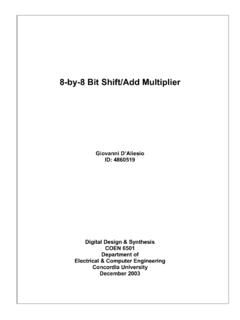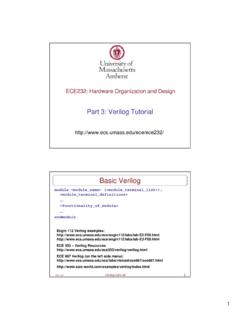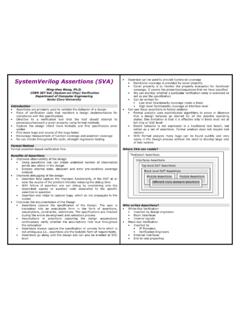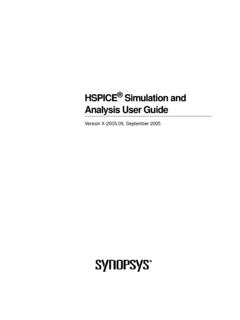Transcription of Verilog HDL: A Guide to Digital Design and Synthesis
1 Verilog HDL. A Guide to Digital Design and Synthesis Samir Palnitkar SunSoft Press 1996. PART 1 BASIC Verilog TOPICS 1. 1 Overview of Digital Design with Verilog HDL 3. 2 Hierarchical Modeling Concepts 11. 3 Basic Concepts 27. 4 Modules and Ports 47. 5 Gate-Level Modeling 61. 6 Dataflow Modeling 85. 7 Behavioral Modeling 115. 8 Tasks and Functions 157. 9 Useful Modeling Techniques 169. PART 2 Advance Verilog Topics 191. 10 timing and Delays 193. 11 Switch- Level Modeling 213. 12 User-Defined Primitives 229. 13 Programming Language Interface 249. 14 Logic Synthesis with Verilog HDL 275. PART3 APPENDICES 319. A Strength Modeling and Advanced Net Definitions 321. B List of PLI Rountines 327. C List of Keywords, System Tasks, and Compiler Directives 343. D Formal Syntax Definition 345. E Verilog Tidbits 363. F Verilog Examples 367. Part 1 Basic Verilog Topics Overview of Digital Design with Verilog HDL. Evolution of CAD, emergence of HDLs, typical HDL-based Design flow, why Verilog HDL?
2 , trends in HDLs. Hierarchical Modeling Concepts Top-down and bottom-up Design methodology,differences between modules and module instances, parts of a simulation , Design block, stimulus block. Basic Concepts Lexical conventions, data types, system tasks, compiler directives. Modules and Ports Module definition, port declaration, connecting ports, hierarchical name referencing. Gate-Level Modeling Modeling using basic Verilog gate primitives, description of andlor and buflnot type gates, rise, fall and turn-off delays, min, max, and typical delays. Dataflow Modeling Continuous assignments, delay specification,expressions, operators, operands, operator types. Behavioral Modeling Structured procedures, initial and always, blocking'and nonblocking statements, delay control, event control, conditional statements,multiway branching, loops, sequential and parallel blocks. Tasks and Functions Differencesbetween tasks and functions, declaration, invocation.
3 Useful Modeling Techniques Procedural continuous assignments, overriding parameters, conditional compilation and execution, useful system tasks. Verilog HDL: A Guide to Digital Design and Synthesis Overview of Digital Design with Verilog " HDL 1s Evolution of Computer Aided Digital Design Digital circuit Design has evolved rapidly over the last 25 years. The earliest Digital circuits were designed with vacuum tubes and transistors. Integrated circuits were then invented where logic gates were placed on a single chip. The first integrated circuit (IC) chips were SS1 (Small Scale Integration) chips where the gate count was very small. As technologies became sophisticated, designers were able to place circuits with hundreds of gates on a chip. These chips were called MS1 (Medium Scale Integration) chips. With the advent of LSI (Large Scale Integration), designers could put thousands of gates on a single chip. At this point, Design processes started getting very complicated, and designers felt the need to automate these processes.
4 Computer Aided Design (CAD)' techniques began to evolve. Chip designers began to use circuit and logic simulation techniques to verify the functionality of building blocks of the order of about 100 transistors. The circuits were still tested on the breadboard, and the layout was done on paper or by hand on a graphic computer terminal. With the advent of VLSI (Very Large Scale Integration) technology, designers could Design single chips with more than 100,000 transistors. Because of the complexity of these circuits, it was not possible to verify these circuits on a breadboard. Computer-aided techniques became critical for verification and Design of VLSI. Digital circuits. Computer programs to do automatic placement and routing of circuit layouts also became popular. The designers were now building gate-level Digital circuits manually on graphic terminals. They would build small building blocks and then derive higher-level blocks from them. This process would , the term Computer-Aided Design ( C A D ) tools refers to back-end tools that perform functions related to place and route, and layout of the chip.
5 The term Computer-Aided Engineering (CAE) tools refers to tools that are used for front-end processes such HDL simulation , logic Synthesis and timing analysis. However, designers use the term C A D and C A B interchangeably. For the sake of simplicity, in this book, we will refer to all Design tools as C A D tools. continue until they had built the top-level block. Logic simulators came into existence to verify the functionality of these circuits before they were fabricated on chip. As designs got larger and more complex, logic simulation assumed an important role in the Design process. Designers could iron out functional bugs in the architecture before the chip was designed further. Emergence of HDLs For a long time, programming languages such as FORTRAN, Pascal, and C were being used to describe computer programs that were sequential in nature. Similarly, in the Digital Design field, designers felt the need for a standard language to describe Digital circuits.
6 Thus, Hardware Description Languages (HDLs). came into existence. HDLs allowed the designers to model the concurrency of processes found in hardware elements. Hardware description languages such as Verilog H D L and vhdl became popular. Verilog HDL originated in 1983 at Gateway Design Automation. Later, vhdl was developed under contract from DARPA. Both verilogB and vhdl simulators to simulate large Digital circuits quickly gained acceptance from designers. Even though HDLs were popular for logic verification, designers had to manually translate the HDL-based Design into a schematic circuit with interconnections between gates. The advent of logic Synthesis in the late 1980s changed the Design methodology radically. Digital circuits could be described at a register transfer level (RTL) by use of an HDL. Thus, the designer had to specify how the data flows between registers and how the Design processes the data. The details of gates and their interconnections to implement the circuit were automatically extracted by logic Synthesis tools from the RTL description.
7 Thus, logic Synthesis pushed the HDLs into the forefront of Digital Design . Designers no longer had to manually place gates to build Digital circuits. They could describe complex circuits at an abstract level in terms of functionality and data flow by designing those circuits in HDLs. Logic Synthesis tools would implement the specified functionality in terms of gates and gate interconnections. HDLs also began to be used for system-level Design . HDLs were used for simulation of system boards, interconnect buses, FPGAs (Field Programmable Gate Arrays), and PALS (Programmable Array Logic). A common approach is to Design each IC chip, using an HDL, and then verify system functionality via simulation . Verilog HDL: A Guide to Digital Design and Synthesis Typical Design Flow A typical Design flow for designing VLSI IC circuits is shown in Figure 1-1. Unshaded blocks show the level of Design representation; shaded blocks show processes in the Design flow.
8 I. I. Behavioral Description (. I. t RTL Description (HDL) #. I. t Logic Synthesis Gate-Level Netlist e Physical Layout l Implementation Figure 1-1 Typical Design Flow Overview of Digital Design with The Design flow shown in Figure 1-1 is typically used by designers who use HDLs. In any Design , specifications are written first. Specifications describe abstractly the functionality, interface, and overall architecture of the Digital circuit to be designed. At this point, the architects do not need to think about how they will implement this circuit. A behavioral description is then created to analyze the Design in terms of functionality, performance, compliance to standards, and other high-level issues. Behavioral descriptions can be written with HDLs. The behavioral description is manually converted to an RTL description in an HDL. The designer has to describe the data flow that will implement the desired Digital circuit. From this point onward, the Design process is done with the assistance of Computer-Aided Design (CAD) tools.)
9 Logic Synthesis tools convert the RTL description to a gate-level netlist. A gate- level netlist is a description of the circuit in terms of gates and connections between them. The gate-level netlist is input to an Automatic Place and Route tool, which creates a layout. The layout is verified and then fabricated on chip. Thus, most Digital Design activity is concentrated on manually optimizing the RTL description of the circuit. After the RTL description is frozen, CAD tools are available to assist the designer in further processes. Designing at RTL level has shrunk Design cycle times from years to a few months. It is also possible to do many Design iterations in a short period of time. Behavioral Synthesis tools have begun to emerge recently. These tools can create RTL descriptions from a behavioral or algorithmic description of the circuit. As these tools mature, Digital circuit Design will become similar to high-level computer programming.
10 Designers will simply implement the algorithm in an HDL at a very abstract level. CAD tools will help the designer convert the behavioral description to a final IC chip. It is important to note that although CAD tools are available to automate the processes and cut Design cycle times, the designer is still the person who controls how the tool will perform. CAD tools are also susceptible to the "GIGO : Garbage I n Garbage Out" phenomenon. If used improperly, CAD tools will lead to inefficient designs. Thus, the designer still needs to understand the nuances of Design methodologies, using CAD tools to obtain an optimized Design . Importance of HDLs HDLs have many advantages compared to traditional schematic-based Design . Designs can be described at a very abstract level by use of HDLs. Designers can write their RTL description without choosing a specific fabrication technology. Logic Synthesis tools can automatically convert the Design to Verilog HDL: A Guide to Digital Design and Synthesis any fabrication technology.









